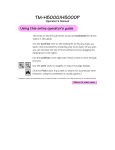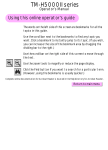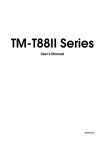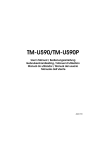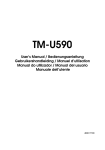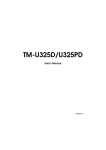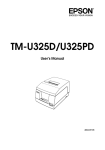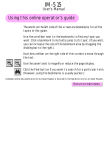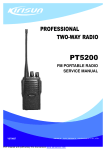Download Seiko U590 - TM B/W Dot-matrix Printer Operator`s manual
Transcript
slip printer TM-U590/U590P Operator’s Manual MICR Option Included 400676902 Printer Parts and Labels Front cover EPSON Table FORW ARD REVE RSE PO ER WER RE ROR SLIPLEASE RELE ASE On/Off switch Paper guide * Slide the paper guide to fit the width of your paper. Slip paper control panel Document table POWER ERROR RELEASE SLIP FORWARD REVERSE RELEASE Labels 2 Ribbon installation label inside front cover 1 Label on the document table CAUTION: Caution labels for drawer kick-out and display module connectors. Quick Reference This Quick Reference will direct you to key areas of this Operator’s Manual. For a complete listing of topics, see the Contents. Printer Parts and Labels Ordering Ribbons inside front cover page viii Where to order ribbons. Setting Up the Printer page 1-1 How to set up the printer. Validating and Verifying Checks page 2-4 How to validate and verify checks using the optional Magnetic Ink Character Recognition (MICR) Reader. Solving Problems page 3-1 How to correct problems. i All rights reserved. No part of this publication may be reproduced, stored in a retrieval system, or transmitted in any form or by any means, electronic, mechanical, photocopying, recording, or otherwise, without the prior written permission of Seiko Epson Corporation. No patent liability is assumed with respect to the use of the information contained herein. While every precaution has been taken in the preparation of this book, Seiko Epson Corporation assumes no responsibility for errors or omissions. Neither is any liability assumed for damages resulting from the use of the information contained herein. Neither Seiko Epson Corporation nor its affiliates shall be liable to the purchaser of this product or third parties for damages, losses, costs, or expenses incurred by purchaser or third parties as a result of: accident, misuse, or abuse of this product or unauthorized modifications, repairs, or alterations to this product, or (excluding the U.S.) failure to strictly comply with Seiko Epson Corporation’s operating and maintenance instructions. Seiko Epson Corporation shall not be liable against any damages or problems arising from the use of any options or any consumable products other than those designated as Original Epson Products or Epson Approved Products by Seiko Epson Corporation. EPSON and ESC/POS are registered trademarks of Seiko Epson Corporation. NOTICE: The contents of this manual are subject to change without notice. Copyright © 1996 by Seiko Epson Corporation, Nagano, Japan. ii FCC CLASS A FCC Compliance Statement For American Users This equipment has been tested and found to comply with the limits for a Class A digital device, pursuant to Part 15 of the FCC Rules. These limits are designed to provide reasonable protection against harmful interference when the equipment is operated in a commercial environment. This equipment generates, uses, and can radiate radio frequency energy and, if not installed and used in accordance with the instruction manual, may cause harmful interference to radio communications. Operation of this equipment in a residential area is likely to cause harmful interference, in which case the user will be required to correct the interference at his own expense. WARNING The connection of a non-shielded printer interface cable to this printer will invalidate the FCC Verification of this device and may cause interference levels which exceed the limits established by the FCC for this equipment. You are cautioned that changes or modifications not expressly approved by the party responsible for compliance could void your authority to operate the equipment. FOR CANADIAN USERS This Class A digital apparatus meets all requirements of the Canadian InterferenceCausing Equipment Regulations. Cet appareil numérique de la classe A respecte toutes les exigenves du Règlement sur le matériel brouileur du Canada. GEREÄUSCHPEGEL Gemäß der Dritten Verordnung zum Gerätesicherheitsgesetz (Maschinenlärminformations- Verordnung-3. GSGV) ist der arbeitsplatzbezogene Geräusch-Emissionswert kleiner als 70 dB(A) (basierend auf ISO 7779). iii DECLARATION OF CONFORMITY Product Name: Printer Type Name: M128B These printers conform to the following Directives and Norms Directive 89/336/EEC EN 55022 (1986 and 1994) Class B EN 50082-1 (1992) IEC 801-2 (1991) IEC 801-3 (1984) IEC 801-4 (1991) Directive 90/384/EEC EN45501: (1992) iv EMI and Safety Standards Applied The following standards are applied only to the printers that are so labeled. (EMC is tested using the EPSON PS-170 power supply) Europe: CE marking EN55022 EN50082-1 EN45501 Safety Standard: TÜV (EN 60950) North America: EMI: FCC Class A Safety standards: UL 1950-2TH-D3 C-UL v About This Manual Setting Up and Using ❏ Chapter 1 contains information on unpacking the printer, and setting it up. ❏ Chapter 2 contains information on using the printer. ❏ Chapter 3 contains troubleshooting information. Reference ❏ Chapter 4 contains specifications. ❏ Appendix A tells how to change the DIP switch and Appendix B lists the EPSON Sales Subsidiaries and their addresses. Warnings, Cautions, and Notes WARNING: Warnings must be followed carefully to avoid serious bodily injury. CAUTION: Cautions must be observed to avoid minor injury to yourself or damage to your equipment. Note: Notes have important information and useful tips on the operation of your printer. vi Introduction Features The TM-U590 and TM-U590P are high-quality POS printers that can print on slip paper. The printers have the following features: ❏ Wide slip paper capability (maximum characters per line: 88 with 7 × 9 font). ❏ Copy printing is possible. ❏ High throughput using bidirectional, minimum distance printing. ❏ Optional Magnetic Ink Character Recognition (MICR) reader that enables the printer to perform consecutive reading and processing of MICR characters and printing endorsements. ❏ EPSON customer display series connection (DM-D102/DM-D203). ❏ Selectable receive buffer size (69 bytes or 4K bytes). ❏ Command protocol based on the ECS/POS® standard. ❏ Automatic Status Back (ASB) function that automatically transmits changes in the printer status. Options ❏ Magnetic Ink Character Recognition (MICR) reader (factory installed option) ❏ Direct connection display modules, DM-D102 and DM-D203 ❏ EPSON power supply unit, PS-170 Accessory ❏ EPSON ribbon cassette, ERC-31(P) Introduction vii Ordering Ribbon Cassettes The TM-U590/U590P uses a long-lasting ribbon cassette. To order ribbon cassettes, contact your dealer or your local affiliate. See Appendix B for a list of EPSON subsidiaries with their addresses and telephone numbers. viii Introduction Contents Quick Reference . . . . . . . . . . . . . . . . . . . . . . . . . . . . . . . . . . . . . . . . . . . . . . . . . . . . . . . i Introduction . . . . . . . . . . . . . . . . . . . . . . . . . . . . . . . . . . . . . . . . . . . . . . . . . . . . . . . . . . vii Chapter 1 Setting Up the Printer Unpacking . . . . . . . . . . . . . . . . . . . . . . . . . . . . . . . . . . . . . . . . . . . . . . . . . . . . . . . . . . . . 1-1 Removing the protective material . . . . . . . . . . . . . . . . . . . . . . . . . . . . . . . . . . . . 1-2 Connecting the Cables and Grounding the Printer . . . . . . . . . . . . . . . . . . . . . . . . . . 1-3 Connecting the Drawer . . . . . . . . . . . . . . . . . . . . . . . . . . . . . . . . . . . . . . . . . . . . . 1-5 Connecting the Display Module . . . . . . . . . . . . . . . . . . . . . . . . . . . . . . . . . . . . . 1-7 Grounding the Printer . . . . . . . . . . . . . . . . . . . . . . . . . . . . . . . . . . . . . . . . . . . . . . 1-7 Connecting the Power Supply . . . . . . . . . . . . . . . . . . . . . . . . . . . . . . . . . . . . . . . 1-8 Installing the Ribbon Cassette . . . . . . . . . . . . . . . . . . . . . . . . . . . . . . . . . . . . . . . . . . . 1-10 Using the Power Switch Cover . . . . . . . . . . . . . . . . . . . . . . . . . . . . . . . . . . . . . . . . . . . 1-12 Self Test . . . . . . . . . . . . . . . . . . . . . . . . . . . . . . . . . . . . . . . . . . . . . . . . . . . . . . . . . . . . . . 1-12 Running the self test . . . . . . . . . . . . . . . . . . . . . . . . . . . . . . . . . . . . . . . . . . . . . . . 1-12 DIP Switch Settings . . . . . . . . . . . . . . . . . . . . . . . . . . . . . . . . . . . . . . . . . . . . . . . . . . . . 1-13 Removing the Paper Guide . . . . . . . . . . . . . . . . . . . . . . . . . . . . . . . . . . . . . . . . . . . . . . 1-14 Chapter 2 Using the Printer Operating the Control Panels . . . . . . . . . . . . . . . . . . . . . . . . . . . . . . . . . . . . . . . . . . . . 2-1 Control Panel . . . . . . . . . . . . . . . . . . . . . . . . . . . . . . . . . . . . . . . . . . . . . . . . . . . . . 2-1 Indicator lights . . . . . . . . . . . . . . . . . . . . . . . . . . . . . . . . . . . . . . . . . . . . . . . . . . . . 2-2 Slip Paper Handling . . . . . . . . . . . . . . . . . . . . . . . . . . . . . . . . . . . . . . . . . . . . . . . . . . . . 2-3 Using the MICR Reader (Option) . . . . . . . . . . . . . . . . . . . . . . . . . . . . . . . . . . . . . . . . 2-4 Reading MICR characters on personal checks . . . . . . . . . . . . . . . . . . . . . . . . . . 2-4 Chapter 3 Troubleshooting Troubleshooting . . . . . . . . . . . . . . . . . . . . . . . . . . . . . . . . . . . . . . . . . . . . . . . . . . . . . . . 3-1 General problems . . . . . . . . . . . . . . . . . . . . . . . . . . . . . . . . . . . . . . . . . . . . . . . . . . 3-1 Printing problems . . . . . . . . . . . . . . . . . . . . . . . . . . . . . . . . . . . . . . . . . . . . . . . . . . 3-1 Paper handling problems . . . . . . . . . . . . . . . . . . . . . . . . . . . . . . . . . . . . . . . . . . . 3-3 Cleaning the Optional MICR Mechanism . . . . . . . . . . . . . . . . . . . . . . . . . . . . . . . . . 3-3 MICA cleaning method (Recommended) . . . . . . . . . . . . . . . . . . . . . . . . . . . . . 3-3 The cleaning procedure . . . . . . . . . . . . . . . . . . . . . . . . . . . . . . . . . . . . . . . . . . . . . 3-3 Explanatin of a cleaning sheet . . . . . . . . . . . . . . . . . . . . . . . . . . . . . . . . . . . . . . . 3-5 Hexadecimal Dump . . . . . . . . . . . . . . . . . . . . . . . . . . . . . . . . . . . . . . . . . . . . . . . . . . . . 3-6 ix Chapter 4 Reference Information Printing Specifications . . . . . . . . . . . . . . . . . . . . . . . . . . . . . . . . . . . . . . . . . . . . . . . . . . 4-1 Paper . . . . . . . . . . . . . . . . . . . . . . . . . . . . . . . . . . . . . . . . . . . . . . . . . . . . . . . . . . . . 4-1 Ribbon Specifications . . . . . . . . . . . . . . . . . . . . . . . . . . . . . . . . . . . . . . . . . . . . . . . . . . . 4-2 MICR Reader (Option) . . . . . . . . . . . . . . . . . . . . . . . . . . . . . . . . . . . . . . . . . . . . . . . . . 4-2 Paper Specifications . . . . . . . . . . . . . . . . . . . . . . . . . . . . . . . . . . . . . . . . . . . . . . . . . . . . 4-3 Electrical Characteristics . . . . . . . . . . . . . . . . . . . . . . . . . . . . . . . . . . . . . . . . . . . . . . . . 4-8 Reliability . . . . . . . . . . . . . . . . . . . . . . . . . . . . . . . . . . . . . . . . . . . . . . . . . . . . . . . . . . . . . 4-8 Environmental Conditions . . . . . . . . . . . . . . . . . . . . . . . . . . . . . . . . . . . . . . . . . . . . . . 4-10 Appendix A Dip Switch Setting Setting the DIP Switches . . . . . . . . . . . . . . . . . . . . . . . . . . . . . . . . . . . . . . . . . . . . . . . . A-1 DIP switch functions . . . . . . . . . . . . . . . . . . . . . . . . . . . . . . . . . . . . . . . . . . . . . . . A-1 Changing the DIP switch settings . . . . . . . . . . . . . . . . . . . . . . . . . . . . . . . . . . . . A-4 Appendix B EPSON Sales Subsidiaries x Chapter 1 Setting Up the Printer Unpacking Your printer box should include these items. If any items are damaged or missing, please contact your dealer for assistance. EPSON FORW ARD REVE RSE PO ER WER RE ROR SLIPLEASE RELE ASE Hexagonal lock screws (These screws are used only for the serial interface) Ribbon Switch Cover See the note on page 1-4 for information about the hexagonal lock screws. Note: When you lift the printer, be sure to hold the bottom of the printer to prevent damage. Setting Up the Printer 1-1 Removing the protective material 1. Open the printer by pulling up on the tab on the front cover. N EPSO D AR RW FO R WE E PO ROR ER LEAS RE IP SL E AS LE RE E RS VE RE Tab 2. Remove the damper from the printer as shown below. N EPSO D AR RW FO R WE E PO ROR ER LEAS RE IP SL E AS LE RE E RS VE RE 3. Store the dampers with the other packing materials and use them when transporting your printer. 1-2 Setting Up the Printer Connecting the Cables and Grounding the Printer You can connect up to five cables to the printer. They all connect to the connector panel on the bottom of the printer, which is shown below: Grounding screw Power supply Drawer kick-out Display module Interface Notes: There are caution labels beside the drawer kick-out connector and the display module connector. Depending on the interface installed, the interface connector on your printer may look different from the one illustrated. Before connecting any of the cables, make sure that both the printer and the computer are turned off. Connecting the computer You need an appropriate interface cable. 1. Plug the cable connector securely into the printer’s interface connector. Setting Up the Printer 1-3 2. Tighten the screws on both sides of the cable connector. Note: Your printer has inch-type hexagonal lock screws installed. If your interface cable requires millimeter-type screws, replace the inch-type screws with the enclosed millimeter-type screws using a hex screwdriver (5 mm). Inch screw Millimeter screw 3. Attach the other end of the cable to the computer. 1-4 Setting Up the Printer Connecting the Drawer WARNING: Use a drawer that matches the printer specification. Using an improper drawer may damage the drawer as well as the printer. CAUTION: Do not connect a telephone line to the drawer kick-out connector; otherwise the printer and the telephone line may be damaged. Plug the drawer cable into the drawer kick-out connector on the bottom of the printer next to the power supply connector. Setting Up the Printer 1-5 Anschließen der Lade WARNUNG: Eine für den Drucker geeignete Lade verwenden. Bei Verwendung einer falschen Lade kann diese oder der Drucker beschädigt werden. ACHTUNG: Kein Telefonkabel an die Schnappsteckerbuchse anschließen, da sonst der Drucker und die Telefonkabel beschädigt werden können. Das Kabel der Lade an die Schnappsteckerbuchse unten am Drucker neben dem Netßzanschluß anschließen. 1-6 Setting Up the Printer Connecting the Display Module Plug the cable connector (provided with the direct connection display module) securely into the printer’s display module connector until it clicks. CAUTION: Be sure not to connect this cable to the drawer kick-out connector, which is to the left of the power supply connector. Do not connect a telephone line to the display connector. If you do, the printer and the telephone line may be damaged. Notes: To remove the cable, squeeze the connector and pull it out. The display module can be used only for the serial interface. Grounding the Printer You need a ground wire to ground your printer. Make sure that the wire is AWG 18 or equivalent. 1. Make sure that the printer is turned off. Setting Up the Printer 1-7 2. Connect the ground wire to the printer using the FG screw on the bottom of the printer, as shown. Connecting the Power Supply Use the optional EPSON PS-170 or equivalent power supply for your printer. WARNING: Make sure that you use the EPSON PS-170 power supply or equivalent. Using an incorrect power supply may cause fire or electrical shock. 1-8 Setting Up the Printer CAUTIONS: When connecting or disconnecting the power supply from the printer, make sure that the power supply is not plugged into an electrical outlet. Otherwise you may damage the power supply or the printer. If the power supply’s rated voltage and your outlet’s voltage do not match, contact your dealer for assistance. Do not plug in the power cord. Otherwise you may damage the power supply or the printer. 1. Make sure that the printer’s power switch is turned off, and the power supply’s power cord is unplugged from the electrical outlet. 2. Check the label on the power supply to make sure that the voltage required by the power supply matches that of your electrical outlet. 3. Plug in the power supply’s cable as shown below. Notice that the flat side of the plug faces down. Note: To remove the DC cable connector, make sure that the power supply’s power cord is unplugged; then grasp the connector at the arrow and pull it straight out. Setting Up the Printer 1-9 Installing the Ribbon Cassette Use the EPSON ERC-31(P) ribbon cassette for your printer. Note the label inside this section that can assist you in replacing the ribbon. CAUTION: Never turn the ribbon knob in the opposite direction of the arrow marked on the cassette; otherwise the ribbon cassette may be damaged. 1. Be sure the printer is not receiving data when you replace a ribbon cassette; otherwise data may be lost. 2. Turn on the printer and open the front cover by pulling up on the tab on the left side of the cover. N EPSO D AR RW FO R WE PO ROR SE ER LEA RE P SLI SE LEA RE E RS VE RE Tab 3. Make sure that the print head is on the right side. 1-10 Setting Up the Printer 4. If you are replacing a used ribbon, grasp the end of the tab and remove it from the printer. See the illustration in step 5 for the location of the tab. 5. Turn the ribbon knob two or three times in the direction of the arrow to take up any slack in the ribbon. Tab 6. Insert the ribbon cassette in the printer and rotate the cassette's knob two or three more times. This is necessary to place the ribbon in the correct position. ARD FORW R POWE R ERRO ASE RELE SLIP ASE RELE RSE REVE Knob Make sure that the ribbon is installed below the print head without wrinkles or creases. (See ➄ on the label for an illustration of where the ribbon should go.) If the ribbon is not installed correctly, remove the cassette and repeat steps 5 and 6 above. Setting Up the Printer 1-11 Using the Power Switch Cover WARNING: If an accident occurs when the power switch cover is attached, unplug the power supply cord from the outlet immediately. Continued usage may lead to fire or shock. You can use the enclosed power switch cover to make sure that the power switch is not accidentally pressed. If you want to use this cover, install it as shown in the illustration below. EPSON FORW ARD REVE RSE PO ER WER RE ROR SLIPLEASE RELE ASE Self Test The self test lets you know if your printer is operating properly. It checks the control circuits, printer mechanisms, print quality, ROM version, and DIP switch settings. This test is independent of any other equipment or software. Running the self test 1. Make sure the printer is turned off and the printer cover is closed properly. 1-12 Setting Up the Printer 2. While holding down the REVERSE button, turn on the printer to begin the self test. (The SLIP light blinks.) 3. Feed a sheet of slip paper into the printer. The printer loads the paper automatically, prints the printer settings, and then ejects the paper. 4. Remove the paper from the printer and feed another sheet of slip paper into the printer to print characters from the character table. Continue to feed slip paper into the printer until the self test prints the following: ***completed*** The printer is ready to receive data as soon as it completes the self test. Note: If you want to pause the self test manually, press the REVERSE button. Press the REVERSE button again to continue the self test. DIP Switch Settings The TM-U590/U590P is set up at the factory to be appropriate for almost all users. It does, however, offer some settings for users with special requirements. It has DIP switches that allow you to change communication settings, such as handshaking and parity check, as well as connection to a customer display. See Appendix A if you need to make any changes. Setting Up the Printer 1-13 Removing the Paper Guide If you will use especially wide paper, you may not want to use the paper guide on the document table. You can remove it, as described below. 1. Open the printer by pulling up on the tab on the front cover. 2. Slide the table to the left and remove it. 3. Loosen the screws and remove the document table from the printer. Screws Note: Be sure not to drop the screws in the printer. 1-14 Setting Up the Printer 4. Turn the document table over, loosen the screws, and remove the plate. Plate Screws 5. Slide the paper guide to the left to remove it. 2 1 Paper guide 6. Replace the plate and install the document table. Note: Be sure to keep the paper guide with the manual. Setting Up the Printer 1-15 Chapter 2 Using the Printer Operating the Control Panels You can control the basic paper feeding operations of the printer with the buttons on the control panels. The indicator lights help you monitor the printer’s status. Control Panel FORWARD REVERSE POWER ERROR RELEASE SLIP RELEASE Buttons The printer and these buttons will not operate when the cover is open. Also these buttons can be disabled with the ESC c 5 command. FORWARD Press the FORWARD button once to advance slip paper one line. You can also hold down this button to feed slip paper continuously. REVERSE Press the REVERSE button once to reverse slip paper one line. You can also hold down this button to reverse slip paper continuously. Using the Printer 2-1 RELEASE Press this button to release slip paper. Indicator lights The control panel lights provide information on printer conditions. Panel lights POWER The POWER light is on when the printer is on. ERROR The printer is off-line when the light is on (except during paper feed using the FORWARD or REVERSE buttons or during self-test printing). This indicates an error when the light blinks. See Chapter 3 for information on what to do. RELEASE This light is on when platen and paper feed roller are released so that slip paper can be inserted. This light is off when platen and paper feed roller are cramped together (during printing on slip paper). SLIP This light is always on except off or blinking status. This light is off when ejecting a slip paper. This light blinks when the printer is in the slip insertion/removal waiting state or personal check insertion/removal waiting state (only when the printer is used with the MICR reader). 2-2 Using the Printer Slip Paper Handling Notes: Use only slip paper that matches the printer’s specifications. See Paper Specifications in Chapter 4. Be sure that the slip is flat, without curls, folds, and wrinkles. 1. Send appropriate control commands from the computer. 2. When the SLIP light blinks, insert the slip paper into the slip paper inlet using the right edge of the slip paper inlet as a guide. (Follow steps ➀ and ➁ in the illustration.) N EPSO D AR RW FO R WE PO ROR SE ER LEA RE P SLI E AS LE RE E RS VE RE 2 1 Note: There is a label on the document table to assist you how to insert slip paper. 3. Make sure you insert the slip paper into the inlet as far as it will go. 4. When the slip sheet is detected by the sensor, the SLIP light is changed from blinking to on and the paper is automatically drawn into the printer and printing begins. Using the Printer 2-3 Note: After the slip is detected, the printer moves the slip back and forth to detect the position of the top edge of the slip. If the setting position of the slip is not correct, the printer takes a few seconds to detect the position of the top edge of the slip. 5. After printing, remove the slip. Using the MICR Reader (Option) If your printer has the factory installed optional Magnetic Ink Character Recognition (MICR) reader that enables the printer to read and process MICR characters on personal checks, read this section. Reading MICR characters on personal checks To use the MICR function with personal checks, follow the steps below: CAUTION: Do not insert checks with staples in them. This may cause paper jams, MICR reading errors, and damage to the MICR head. Note: Be sure that the checks are flat, without curls, folds, or wrinkles. 1. Wait until the computer sends the FS a 0 command to the printer, causing it to enter the MICR mode. The SLIP light blinks. 2-4 Using the Printer 2. Turn the check over so that it is face down with the MICR characters on the right-hand side. The MICR characters must be next to the right edge of the paper inlet. N EPSO D AR RW FO R WE PO ROR SE ER LEA RE P SLI SE LEA RE E RS VE RE 3. Insert the check straight into the paper inlet, using the right edge of the paper inlet as a guide. 4. Insert the check as far as it will go. The printer will detect the check and start drawing it in. 5. When the printer starts drawing it in, let go of the check immediately. The SLIP light quits blinking but stays on. 6. When printing and MICR reading are finished, the printer ejects the check and the SLIP light starts blinking again. 7. Remove the check by pulling it straight up; do not pull it at an angle. The SLIP light goes on. See Chapter 3 to find out how to clean the MICR mechanism. Using the Printer 2-5 Chapter 3 Troubleshooting Troubleshooting This chapter gives solutions to some printer problems you may have. General problems The lights on the control panel do not come on. Make sure that the power supply cables are correctly plugged into the printer, the power unit, and to the power outlet. Make sure that power is supplied to the power outlet. If the outlet is controlled by a switch or timer, use another outlet. Printing problems An ERROR light is blinking and the printer does not print. First, turn off the printer and check for a paper jam. (See the paper jam description on page 3-3.) If there is no paper jam, turn off the printer and turn it back on after about 10 seconds. If the ERROR light is still flashing, contact a qualified service person. The ERROR light is off, but nothing is printed. Try to run the self test to check that the printer works properly. See the self test instructions in Chapter 1 to run the self test. If the self test does not work, contact your dealer or a qualified service person. Troubleshooting 3-1 If the self test works properly, check the following: 1. Check the connection at both ends of the interface cable between the printer and the computer. Also make sure that this cable meets the specifications for both the printer and the computer. 2. The data transmission settings may be different between the printer and computer. Make sure that the printer’s DIP switch settings for data transmission are the same as the computer’s. You can print the printer’s interface settings using the self test. If the printer still does not print, contact your dealer or a qualified service person. The printer sounds like it is printing, but nothing is printed. The ribbon cassette may not be installed properly. See the instructions in Chapter 1. The ribbon may be worn out. Replace the ribbon cassette as described in Chapter 1. The printout is faint. The ribbon may be worn out. Replace the ribbon cassette as described in Chapter 1. A line of dots is missing in the printout. The print head may be damaged. Stop printing and contact your dealer or a qualified service person. 3-2 Troubleshooting Paper handling problems Paper is jammed inside the printer. CAUTIONS: Do not touch the print head because it can be very hot after printing continuously for a long time. Do not move the print head carriage. To clear a paper jam, follow the steps below: 1. Turn the printer off and open the front cover. 2. Remove the jammed paper. Cleaning the Optional MICR Mechanism MICA cleaning method (Recommended) Cleaningpoint Use cleaning sheet MICR head department Moistened Cleaning sheet MICA system department Adhensive cleaning sheet Frequency 6000 times or for one month 6000 times or for one month * Combine these 2 procedures, if you encounter frequent MICR reading errors. The cleaning procedure During in the self test mode 1) Confirm to set a roll paper and a ribbon cassette to make use a printer mechanism properly. Troubleshooting 3-3 2) Turn off the power switch. 3) Open a front cover(rid). 4) Turn on the power switch while turning on “JOURNAL/ SLIP FEED button. 5) Push “JOURNAL/SLIP FEED” button 3 times. 6) Close a SLIP front cover (rid). 7) Following message will be printed on receipt paper and “SLIP” LED flushes. ******WAVEFORM TRANSMISSION MODE ***** Please set back 8) Peel off the pasteboard portion of a designated point of a cleaning sheet. * This procedure, 8) , is required only for a adhesive cleaning sheet. Figure 2. Adhesive Cleaning Sheet F F Fi 3-4 Troubleshooting 9) As a check paper, insert a cleaning sheet into a printer. * Set yellow non-stick side to be upside when cleaning using adhesive sheet. 10) Remove and do a sheet after cleaning sheet discharge. 11) Turn off the power switch. Command code sequence 1) MICA cleaning command <FS c> was installed to clean up. 2) Carry our from 8) to 10) described above in the self test mode. NOTES In case of using an adhesive cleaning sheet, 1) peel off only desinated pasteboard. 2) insert from correct derection, and 3) insert as peeled portion to be upside. Explanatin of a cleaning sheet Moistened Cleaning sheet PRESAT brand (KIC) “CHECK READER CLEANING CARD” or equivalent cleaning sheet is required. Adhesice cleaning sheet (Refer to Figure 2) Part Name : Sheet roller cleaning, A Part Number : 1038046 Troubleshooting 3-5 Hexadecimal Dump This feature allows experienced users to see exactly what data is coming to the printer. This can be useful in finding software problems. When you turn on the hex dump function, the printer prints all commands and other data in hexadecimal format along with a guide section to help you find specific commands. To use the hex dump feature, follow these steps: 1. After you make sure that the printer is off, open the cover. 2. Hold down the REVERSE button while you turn on the printer. 3. Close the cover. 4. Run any software program that sends data to the printer. The printer prints “Hexadecimal Dump” and then all the codes it receives in a two-column format. The first column contains the hexadecimal codes and the second column gives the ASCII characters that correspond to the codes. Hexadecimal Dump 1B 40 1B 21 00 41 42 43 44 45 46 47 48 49 4A 4B .@.!.ABCDEFGHIJK 4C 4D 4E 4F 50 51 52 53 54 55 56 57 58 59 5A 0C LMNOPQRSTUVWXYZ. ❏ A period (.) is printed for each code that has no ASCII equivalent. ❏ During the hex dump all commands except DLE EOT and DLE ENQ are disabled. 5. Open the cover to set the printer off line so that it will print the last line. 6. Close the cover and turn off the printer or reset it to turn off the hex dump mode. 3-6 Troubleshooting Chapter 4 Reference Information Printing Specifications Paper Printing method: Serial impact dot matrix Head wire configuration: 9-pin vertical line, 0.353 mm (1/72-inch) wire pitch Head wire diameter: 0.29 mm (.01") Printing direction: Bidirectional, minimum distance printing Number of characters: Alphanumeric characters: 95 International characters: 32 Extended graphics: 128 × 10 pages (including space page) Character structure: Font A: 9 × 9, 3-dot spacing (in half-dot units) Font B: 7 × 9, 2-dot spacing (in half-dot units) Larger spacing can be set by using ESC SP. Character size and printing speed Character structure (Horizontal dots × vertical dots) Character spacing (half dots) Characters per inch Characters per second (carriage moving speed) Characters per line Character size (width×height) 9×9 3 dots 12.5 233 66 1.6 × 3.1 mm (.06" × .12") 7×9 2 dots 16.7 311 88 1.3 × 3.1 mm (.05" × .12") Reference Information 4-1 Ribbon Specifications Type: Exclusive cassette ribbon Ribbon cassette specifications: Part number: ERC-31 (P), ERC-31(B) Color: (P) Purple (B) Black Ribbon life: (P) 7,000,000 characters (B) 4,500,000 characters (when 1 character=18 dots) MICR Reader (Option) The MICR reader is a factory-installed option. Available fonts: E-13B, CMC7 Reading method: Magnetic bias Recognition rating: 98% or more at 25°C (75°F) Rating = ([total checks – number misread or not identified]/total checks) × 100 Check paper tested is EPSON standard check paper. Checks must be flat, without curls, folds, or wrinkles. The magnetic bias method is used for reading. Paper type: Normal check paper with thickness of 0.09 to 0.36 mm (0.0035 to 0.141”) Size: 70 mm × 70 mm to 210 mm × 297 mm (A4) (2.76” × 2.76” to 8.27” × 11.69”) 4-2 Reference Information Paper Specifications Paper feed method: Friction feed Paper feed pitch: Default 4.23 mm (1/6”) 0.176 mm (1/144”) can be set by a command Paper feed speed: Approximately 60.3 msec/line (4.23 mm (1/6”) feeding) Approximately 86.4 mm/second (3.4 inches/second) (continuous feeding) Reference Information 4-3 Paper Paper type: Normal paper Carbon copy paper Pressure sensitive paper Total thickness: 0.09 to 0.36 mm (.0035 to .0141”) See “Copy capability and paper thickness” on the next page for more information. Size (W × L): Ambient temperature and copy capability 70 mm × 70 mm to 210 mm × 297 mm (A4) (2.76” × 2.76”to 8.27” × 11.69”) Copy capability is greatly influenced by the ambient temperature, so printing must be performed under the conditions described in the table below. Relationship between ambient temperature and number of copies Number of copies Ambient temperature (print mode) Original + 4 copies Approx. 20° to 45°C (68° to 113°F) Original + 1 to 3 copies 5° to 45°C (41° to 113°F) 4-4 Reference Information Copy capability and paper thickness: Normal paper (single-ply): 0.09 to 0.2 mm (.0035 to .0079”) Carbon copy paper combination: 5 sheets maximum (original + 4 copies) at 20° to 45°C (68° to 113°F) Backing paper: 0.06 to 0.15 mm (.0023 to .0059”) Copy and original: 0.04 to 0.07 mm (.0015 to .0028”) Carbon paper: Approximately 0.035 mm (.0014”) Total thickness: 0.30 mm (.0118”) or less (for any combination, from a single original to an original + 3 copies) 0.36 mm (.0141”) or less (for any combination, from a single original to an original + 4 copies) Pressure sensitive paper: 5 sheets maximum (original + 4 copies) at 20° to 45°C (68° to 113°F) Backing paper: 0.06 to 0.15 mm (.0023 to .0059”) Copy and original: 0.06 to 0.075 mm (.0023 to .003”) Total thickness: 0.24 mm (.0094”) or less (original to original + 3 copies) 0.30 mm (.0118”) or less (original + 4 copies) Note: When using multi-ply paper that consists of an original and three or four copies, be sure to print with a 9 × 9 font. If a 7 × 9 font is used, some characters on some of the copies may not be readable. Reference Information 4-5 Notes on slip paper ❏ The slip paper must be flat, without curls or wrinkles, especially at the top edges. Otherwise, the paper may rub against the ribbon and become dirty. ❏ There must be no glue on the bottom edge. Choose slip paper carefully since paper feeding and insertion are affected by gluing conditions (such as glue quality, method, and length) and glue location (see the illustration below). Be especially careful when slip paper is wide and has glue on the left edge, since it may not feed in a straight line. . OK to use Paper feed direction Do not use Use carefully OK to use Glued area ❏ Since the BOF sensor uses a photo sensor, do not use paper that has holes at the sensor position, or is translucent. ❏ Since the TOF sensor uses a reflective photo sensor and it detects from the back of slip paper, do not use paper that has holes or dark portions with low reflection (less than 40% reflection) at the sensor position. 4-6 Reference Information 31 8 Form stopper position 18.9 MICR head 1.8 1.3 TOF sensor position 38.5 39 37.2 Center of the print head 18 Slip feeding roller position 21.9 Slip side guide Paper feed direction BOF sensor 3.6 [ All the numeric values are typical. ] 15 24 10 Area where paper holes are prohibited and reflection rate for the back of paper should be 40% or more. Paper holes and translucence prohibited area. Paper feed direction [Units: mm (All the numeric values are typical.)] ❏ Use thinner paper (N30 or equivalent) between the top and bottom sheets of multi-ply paper. If thick paper is used, the copy capability is lowered. Reference Information 4-7 Notes: When inserting slip paper, be sure to use the slip side guide and form stopper. If you insert the slip paper exceeding the form stopper, the slip paper may be ejected. Do not print on the slip paper in the reverse paper feed direction. Electrical Characteristics Supply voltage: +24 VDC ± 10% (optional power supply: EPSON PS-170) Ripple voltage: 300mVpp or less (only when the printer is used with the MICR reader). Current Operating: Mean: approximately 1.9A (character font A α-N all columns consumption: (at printing) 24V, except for Peak: approximately 8.0A (20 msec) drawer kick-out When the print platen is released: driving) 2.0A (200 msec) Standby: Mean: approximately 0.3A Reliability Life (when printing alphanumeric characters): 4-8 Reference Information Mechanism: 12,000,000 lines Print head: 150 million characters (when printing in the average of 2 dots/wire per character) MICR reader mechanism (only when the printer is used with the MICR reader): 240,000 passes The MICR reader is defined to have reached the end of its life when it reaches the beginning of the Wearout Period. MTBF: 180,000 hours Failure is defined as Random Failure occurring at the time of the Random Failure Period. MCBF: 29,000,000 lines This is an average failure interval based on failures relating to wearout and random failures up to the life of 12 million lines. Reference Information 4-9 Environmental Conditions Temperature: Humidity: Operating: 5° to 45°C (41° to 113°F) Storage: -10° to 50°C (14° to 122°F) (except for paper) Operating: 10 to 90% RH Storage: 10 to 90% RH (except for paper) Notes: When the temperature is 34°C, the humidity must be 90% or less. When the temperature is 40°C, the humidity must be 65% or less. When the temperture is 45°C, the humidity must be 50% or less. 4-10 Reference Information Appendix A Dip Switch Setting Although the factory settings are best for almost all uses, if you have special requirements, you can change the DIP switch. Setting the DIP Switches DIP switch functions Your printer has two sets of DIP switches. The functions of the switches are shown in the following tables. Serial interface specification Set 1 SW Function ON OFF 1-1 Data receive error Ignored Prints “?” 1-2 Receive buffer capacity 69 bytes 4K bytes 1-3 Handshaking XON/XOFF DTR/DSR 1-4 Data word length 7 bits 8 bits 1-5 Parity check Enabled Disabled 1-6 Parity selection Even Odd 1-7 Transmission speed (See the table below) 1-8 Dip Switch Setting A-1 Transmission Speed Transmission Speed (BPS)-bits per second 1-7 1-8 2400 ON ON 4800 OFF ON 9600 ON OFF 19200 OFF OFF Set 2 SW Function ON OFF 2-1 Handshaking (BUSY condition) Receive buffer full Off line or receive buffer full 2-2 Customer display (DM-D) connection Connected Not connected 2-3~ 2-4 Undefined — 2.5~ 2.6 Internal use 2-7* I/F pin 6 reset signal Enabled Disabled 2-8* I/F pin 25 reset signal Enabled Disabled Fixed to Off * With a RS-485 serial interface specification (a dealer option), DIP switches 2-7 and 2-8 are ignored. Notes: • Changes in DIP switch settings (excluding switches 2-7 and 2-8 interface reset signals) are recognized only when the printer power is turned on or when the printer is reset by using the interface. If the DIP switch setting is changed after the printer power is turned on, the change does not take effect until the printer is turned on again or is reset. • If you turn on DIP switch 2-7 or 2-8 while the printer is turned on, the printer may be reset, depending on the signal state. DIP switches should not be changed while the printer power is on. A-2 Dip Switch Setting Parallel interface specification Set 1 SW Function ON OFF 1-1 Auto line feed Always enabled Always disabled 1-2 Receive buffer capacity 69 bytes 4K bytes 1-3 ~ 1-8 Undefined — — SW Function ON OFF 2-1 Handshaking (BUSY condition) •Receive buffer full •Reading data •Off-line •Receive buffer full •Reading data 2-2 Reserved (Do not change settings) Fixed to Off 2-3 ~ 2-4 Undefined — 2-5 ~ 2-7 Reserved (Do not change settings) Fixed to Off 2-8 I/F pin 31 reset signal (Do not change settings) Fixed to On Set 2 Notes: • Changes in DIP switch settings (excluding switch 2-8 interface reset signal) are recognized only when the printer power is turned on or when the printer is reset by using the interface. If the DIP switch setting is changed after the printer power is turned on, the change does not take effect until the printer is turned on again or is reset. • If you turn on DIP switch 2-8 while the printer is turned on, the printer may be reset, depending on the signal state. DIP switches should not be changed while the printer power is on. Dip Switch Setting A-3 Changing the DIP switch settings If you need to change settings, follow the steps below to make your changes: CAUTION: Turn off the printer while removing the DIP switch cover to prevent an electric short, which can damage the printer. 1. Make sure the printer is turned off. 2. Remove the screw from the DIP switch cover. Then take off the DIP switch cover, as shown in the illustration below. DSW1 DSW2 3. Set the switches using a pointed tool, such as tweezers or a small screwdriver. 4. Replace the DIP switch cover. Then secure it with the screw. The new settings take effect when you turn on the printer. A-4 Dip Switch Setting Appendix B EPSON Sales Subsidiaries EPSON AMERICA INC./OEM DIV. 20770 Madrona Ave. Torrance, CA 90559-2842 U.S.A. Tel : 1-310-787-6300 Fax : 1-310-782-5350 EPSON EUROPE B.V. Prof. J.H. Bavincklaan 5 1183 AT Amstelveen The Netherlands Tel : 31-(0)20-5475-251 Fax : 31-(0)20-6454-315 EPSON Deutschland GmbH Zülpicher Strasse 6, 40549 Düsseldorf 11, Germany Tel : 49-(0)211-5603152 Fax : 49-(0)211-5603319 EPSON U.K. LIMITED Campus 100 Maylands Ave. Hemel Hempstead Herts. HP2 7TJ United Kingdom Tel : 44-1(0)442-61144 Fax : 44-1-(0)442-227-244 EPSON FRANCE S.A. 68 Bis Rue Marjolin B.P. 320 92305 Levallois Perret Cedex, France Tel : 33-(0)1-40-87-38-62 Fax : 33-(0)1-47-37-15-10 EPSON IBERICA, S.A. Avda. de Roma, 18-26 08290 Cerdanyola del Vallès (Barcelona), Spain Tel : 34-(9)3-582-2500 Fax : 34-(9)(3-582-1555 EPSON ITALIA S.P.A. V.le F IIi Casiraghi, 427 20099 Sesto Si Giovanni (Milan), Italy Tel : (39)226-2331 Fax (39)2244-0750 EPSON SINGAPORE PTE. LTD. No. 1 Raffles Place #26-00 OUB Centre Singapore, 0104 Tel : 5-530477 Fax : 5-5338119 EPSON Sales Subsidiaries B-1 EPSON HONG KONG LIMITED 25/F., Harbor Centre, 25, Harbor Road, Wanchai, Hong Kong Tel : 852-2-585-4663 Fax : 852-2-827-4346 EPSON TAIWAN TECHNOLOGY & TRADING LTD. 10f, No. 287, Nanking E. Road, Sec. 3 Taipei, Taiwan R.O.C. Tel : 886-(0)2-717-7360 Fax : 886-(0)2-718-9366 SEIKO EPSON CORP. KOREA OFFICE 10F, KIL 63 Building 60, Yoido Dong, Youngedungpo-Ku, Seoul, Korea Tel : 82-(0)2-784-6027 Fax : 82-(0)2-769-1049 EPSON AUSTRALIA PTY. LTD. 70 Gibbes Street, Chatswood NSW 2067 Australia Tel : 61-(0)2-415-9000 Fax : 61-(0)2-417-0077 EPSON HANBAI CO., LTD. TOKYO OFFICE: OSAKA OFFICE: B-2 EPSON Sales Subsidiaries 3F Building Kawaguchi Fuda Chofu-Shi Tokyo 182 Japan Tel : 0424-99-7829 Fax : 0424-99-7834 13F Shin-Osaka Daiichi-Seimei Bldg. 5-24 3-Chome Miyahara Yodogawa-ku Osaka 532 Japan Tel : 06-350-4964 Fax : 06-350-4968






















































